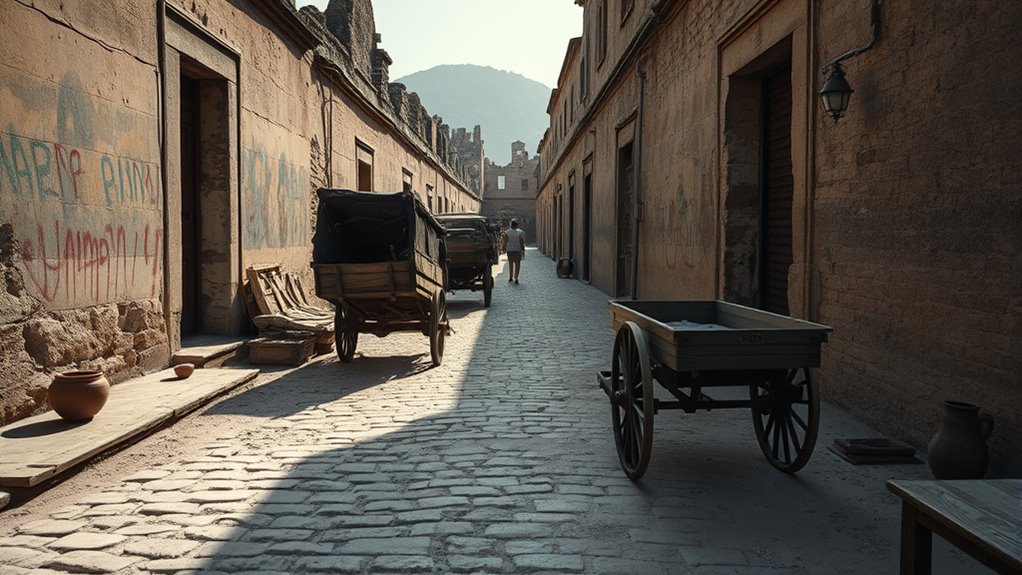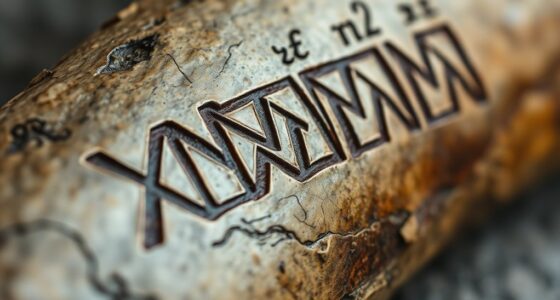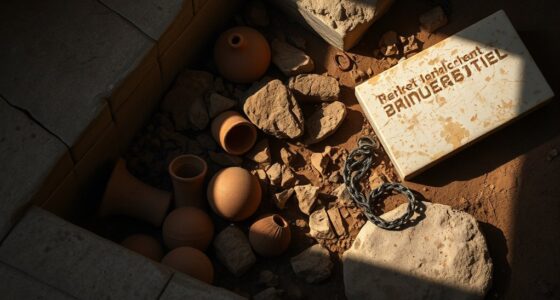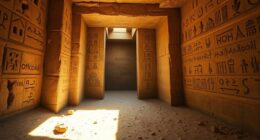Recent excavations at Pompeii reveal stunning frescoes and artifacts that capture daily life just before the eruption. These vivid wall paintings show scenes from markets, domestic life, and religious rituals, offering a rare glimpse into ancient Roman culture. Scientific analysis of the volcanic ash helps date the artworks precisely and understand the natural forces that preserved them. If you look further, you’ll discover more about how Pompeii’s past continues to astonish us today.
Key Takeaways
- Recent excavations at Pompeii reveal detailed frescoes depicting daily life, rituals, and entertainment.
- Scientific analysis of volcanic ash confirms the frescoes were created shortly before the eruption.
- Preserved artworks offer insights into Pompeii’s social customs, aesthetics, and domestic scenes.
- Ash’s natural preservation allows for detailed study of craftsmanship and cultural practices.
- New discoveries enhance understanding of Pompeii’s abrupt end and its enduring historical significance.
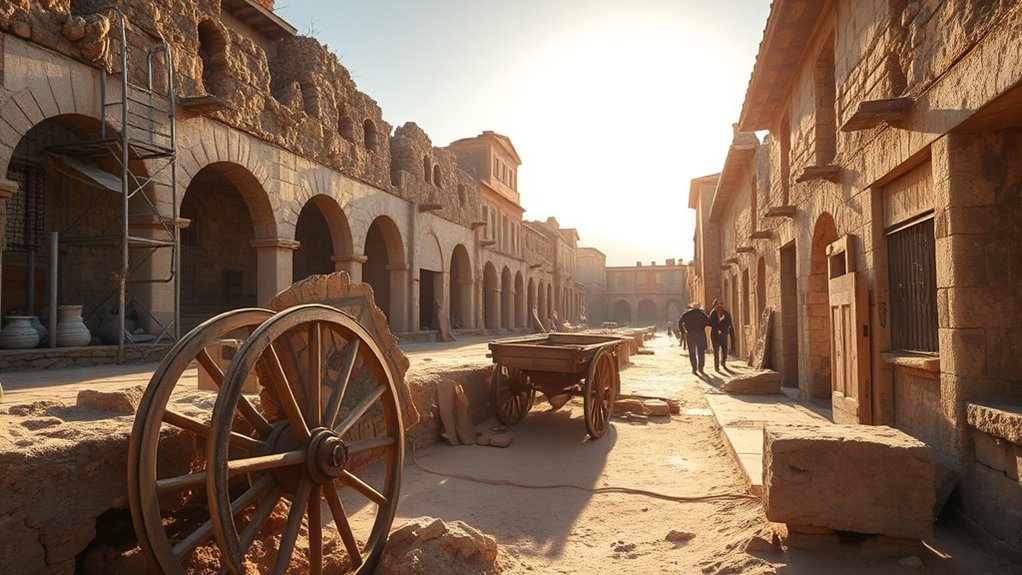
Recently, new excavations at Pompeii have uncovered even more of the ancient city’s secrets, offering fresh insights into daily life before the eruption. As you explore these discoveries, you realize how much history is still buried beneath layers of volcanic ash, waiting to tell its story. Among the most enthralling finds are the ancient frescoes, which vividly depict scenes of everyday life, religious rituals, and entertainment. These colorful wall paintings give you a rare glimpse into the aesthetic sensibilities and social customs of Pompeii’s residents. The vivid imagery transports you back in time, allowing you to imagine the bustling streets, lively markets, and intimate domestic spaces that once thrived here.
Scientists have employed volcanic ash analysis to better understand the context of these artifacts. By examining the mineral composition and layering of the ash, researchers can precisely date the eruptions and identify the environmental conditions at the time. This meticulous analysis helps confirm that many of the frescoes were created shortly before the catastrophic event, providing a snapshot of a city on the brink of disaster. The ash’s chemical signatures also reveal details about the volcanic activity, allowing you to understand how the eruption unfolded and why Pompeii was so rapidly buried. This scientific approach adds a layer of depth to your appreciation of the city’s history, emphasizing the power of natural forces that preserved its legacy so remarkably. Volcanic ash preservation
Walking through the excavations, you’re struck by the preservation of these artworks beneath the volcanic layer. The frescoes, once fragile, have survived centuries thanks to the volcanic ash acting as a natural preservative. Their discovery offers a rare, detailed view into Pompeii’s artistic and cultural life. You might find yourself studying a scene of a banquet or a mythological story, marveling at the craftsmanship and the stories they tell. These images, frozen in time by the ash, serve as a bridge connecting you to the lives of ordinary Romans—families, workers, and artists who once called Pompeii home.
As you continue to explore, you realize the significance of integrating archaeological findings with scientific analysis. The combination of ancient frescoes and volcanic ash analysis isn’t just about uncovering relics; it’s about reconstructing a moment in history with precision and respect. Each discovery deepens your understanding of how a vibrant city was abruptly halted, yet eternally preserved beneath the ash. Pompeii’s new excavations continue to rewrite what you thought you knew about ancient life, making it clear that even in destruction, there’s an enduring story waiting to be told.
Frequently Asked Questions
What New Artifacts Have Been Discovered in the Recent Excavations?
In recent excavations, you discover fascinating new artifacts like ancient jewelry and preserved organic remains. These findings offer a glimpse into daily life in ancient Pompeii, showcasing personal adornments and food or plant remnants. The jewelry highlights craftsmanship, while organic remains reveal what people ate or used daily. You get a rare opportunity to connect with the past through these well-preserved objects, deepening your understanding of Pompeii’s vibrant ancient community.
How Do the New Findings Change Our Understanding of Pompeii’S Inhabitants?
You see that the new findings reveal more about Pompeii’s inhabitants, changing your view of their ancient diet and social stratification. These artifacts show the variety of foods they ate and highlight differences between social classes. You realize that wealthier residents had access to different, perhaps richer, diets, while others relied on simpler foods. These discoveries deepen your understanding of social dynamics and daily life in Pompeii before the eruption.
Are There Plans to Preserve the Newly Uncovered Structures?
You might find it fascinating that plans are already underway for archaeological preservation and site conservation of the newly uncovered structures. These efforts aim to protect Pompeii’s fragile remains from weather and human impact, ensuring future generations can explore its history. Coincidentally, ongoing conservation projects often lead to discoveries about ancient techniques, reinforcing the importance of preserving such invaluable archaeological sites and maintaining their integrity for study and education.
How Long Will the Ongoing Excavation Process Take?
You wonder about the excavation timeline and preservation efforts. The ongoing excavation process can take several years, depending on the site’s complexity and funding. Preservation efforts are prioritized to protect uncovered structures during and after excavation. You should stay updated with the archaeological team’s reports, as they aim to balance uncovering new findings with ensuring the preservation of this ancient city for future generations.
Can Visitors Access the New Excavation Sites Currently?
Imagine stumbling upon a hidden world—right now, you can’t access the new excavation sites due to ongoing work. Visitor restrictions are in place to protect these fragile archaeological areas, so access is limited. While you might see some parts from designated viewpoints, full archaeological access isn’t available yet. Keep an eye on updates, because someday soon, you’ll be able to explore these incredible discoveries firsthand and uncover history’s secrets.
Conclusion
As you explore Pompeii’s new excavations, you realize you’re stepping into a time capsule, where daily life is frozen in ash—like a modern Snapchat story preserved in volcanic ice. Every artifact and ruin offers a glimpse into ancient moments, reminding you that history isn’t just about the past but a timeless story we still live today. So, next time you scroll through your feed, think about how you’re also part of a continuous, living story — even if it’s not in 79 AD.
